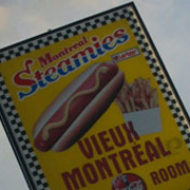Last night I attended the book launch for Tara Rodgers’ Pink Noises: Women on Electronic Music and Sound (Duke University Press, 2010). The book consists of a theoretical introduction and interviews with 24 women in electronic music and sound. In many ways, it is a classic work of feminist recovery as the histories of these fields are still largely told by men and privilege the work of men. I already had my autographed copy, but it was fun to go and congratulate Tara (who is finishing up an excellent dissertation at McGill-a feminist history of synthesized sound).
It was also a great opportunity to check out the Oboro space, which is a real resource for Montreal new media artists. Although I have a pretty well-stocked home studio at this point, there are times you have to work in a space that’s actually set up for audio, and their post-production studio looked really nice. They also had lots of other configurable spaces for artists working in a wide range of media. I am thinking about joining, partly to support it, and partly because I may want to use that post-production studio at some point.
As a special bonus, I asked some questions and my friend and colleague at Concordia Kim Sawchuk treated me to a history of the space and to a history of Studio XX, another important Montreal arts institution across the hallway. Not surprisingly, Oboro is partly an artifact of a combination of cheap real estate and good planning by artists in the 1990s (there is no doubt a similar story to be told about Casa del Popolo and Sala Rosa). As I said to Kim, I hate to sound like a real estate determinist, but there is a way in which the basic cost of living and costs of space are directly connected with an arts community and being able to pursue meaningful projects rather than simply working to sustain oneself.
